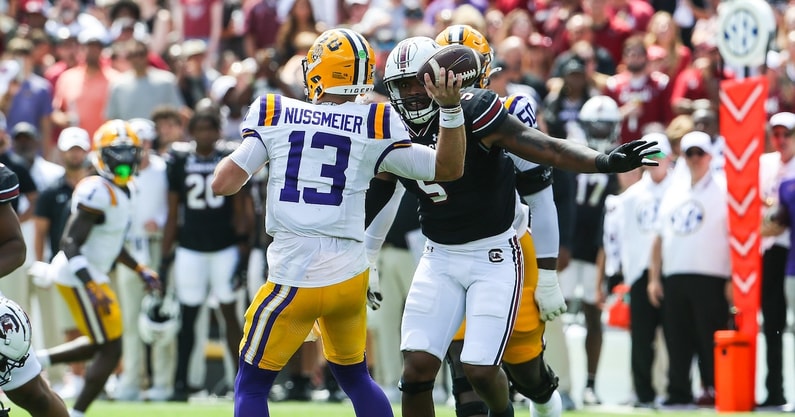SEC shares video clarifying controversial calls from South Carolina-LSU

An official account for the Southeastern Conference shared a video on Friday afternoon clarifying several calls from the last weekend of college football action, including three from the recent South Carolina/LSU game.
National Coordinator of Officials Steve Shaw, who formerly served as the SEC’s coordinator officials until current director John McDaid took over in 2020, narrates the explanations.
The first play featured is the horse collar from South Carolina defender Kyle Kennard on LSU quarterback Garrett Nussmeier. It begins at the 1:11 mark in the linked video.
As Nussmeier was contacted by Kennard, he threw a pass that was intercepted by Gamecocks cornerback OD Fortune and returned for a touchdown.
Shaw begins his explanation by noting that rule changes before this year now call for a foul to be assessed for a horse collar inside the tackle box. Before that shift, only horse collar tackles outside the tackle box were called.
[Join GamecockCentral for great coverage, great communuty]
The biggest point of contention, the question that many had about the play, was whether or not Kennard’s effort actually met the definition of a horse collar tackle.
“We define a horse collar tackle any time a defender grabs the inside, back, or side collar of the shoulder pads or jersey, or even the nameplate area, and abruptly pulls the ball carrier down. It’s a foul, and that’s what we have here,” said Shaw.
The official also noted that, because the penalty took place before the interception, the LSU offense subsequently kept possession of the football
The video also addresses a “two-play vignette” from the game looking at pre-snap action, which Shaw described as a “point of emphasis” for 2024.
[On3 App: Get South Carolina push notifications from GamecockCentral]
LSU was called in one instance for a delay of game penalty when on defense. This sequence begins at 5:30 in the above video.
“New rule language this year makes it clear that any movement that simulates action at the snap by either team, offense or defense, is a foul,” Shaw said. We’re going to see that the defense, they’re going stem or shift. But, as they do, we see number 35, as they shift, he pumps his arms, simulating the start of the play. From the end zone, we can see that this is a coordinated action, as the linebacker, number 18, he gives a hard count and the defensive line shifts.”
[Win two tickets to the South Carolina-Ole Miss football game]
The second play in the sequence highlights a false start penalty on South Carolina center Vershon Lee.
Top 10
- 1New
OC "Warm" Board
Names that make sense
- 2
WBB: Gamecocks win
South Carolina vs. Bowling Green
- 3Trending
MAJOR storyline
Latest on NIL funding
- 4
Thursday Insider
Thoughts on a couple OC names
- 5Trending
Studying Furrey’s offense
Some things we saw after watching hours of Mike Furrey’s Limestone offense
Get the Daily On3 Newsletter in your inbox every morning
By clicking "Subscribe to Newsletter", I agree to On3's Privacy Notice, Terms, and use of my personal information described therein.
This shift does not have the hand-pumping action,” Shaw says of the LSU defense. “It does not simulate action at the snap. There’s a slight flinch by the snapper, so this foul is on the offense for false start, as the defense did not simulate action at the snap. These differences are very subtle and ultimately a judgment by the officials on the field. The point of emphasis is designed to get a fair and clear starting signal.”
In these three instances, and the others from across the country, the NCAA highlights why certain calls were made correctly in games.
In the South Carolina/LSU contest, there were other plays that were much more controversial.
Among them, plus more: a blocked punt that Tigers head coach Brian Kelly said was illegal, an offensive pass interference call on South Carolina, an unnecessary roughness penalty on the Gamecocks that wiped out a second pick-six, a hit to the helmet on LaNorris Sellers during a pass, and a no-call on what Shane Beamer said were two clear instances of it on the final play of the game.
None of these plays were addressed, and the SEC declined to comment when reached by GamecockCentral.com the week after the game in Columbia.
“The SEC communicates directly each week with its coaches to address any questions or concerns they may have related to officiating. Those conversations between the head coach and conference office are considered confidential.”
LSU’s Kelly said the league provided him feedback that the blocked punt was legal, but that going forward, the SEC was going to change the way it rules on the same play.
Sources told GamecockCentral.com that the University of South Carolina sent in 14 plays for review to the league office in an effort to solicit feedback and clarification on the calls from John McDaid, who typically sends back a video response.
“So there were some certainly that I maybe didn’t like what he said, but I get it,” Beamer said earlier this week. “There were some that I absolutely was on board with with his response. And there were a couple that frankly, we can agree to disagree on some of them, as well.”